Never-before-seen Images Of Human Fetus Brain Activity

Until very recently, imaging a baby’s brain activity in the womb was very difficult. At present, and thanks to a more advanced technique, we already have high quality images that allow us to better understand certain aspects of our development that until now were unknown.
Fetal brain magnetic resonance imaging (MRI) is a complementary diagnostic method to ultrasound that many moms undergo for a very specific reason:.
These tests are usually carried out from the 20th week of pregnancy, just when the cerebral corpus callosum has already formed and the diagnoses gain in security. Let us remember that the fetus is suspended in an amniotic universe, in that liquid world where the resolution through magnetic resonance imaging is of poor quality, where any movement completely breaks the clear data collection.
These types of perinatal tests usually have a 50% success rate when identifying any problem. Now, all this has just changed completely. Today we have just taken a giant step forward and we now have much more precise algorithms with which to make near-perfect readings of a baby’s brain activity.
What has been discovered in these first diagnostic tests has been a revolution in the field of perinatal medicine. We explain them below.

Brain activity of premature babies
In the upper image we can see the MRI of a fetus of 20 weeks and another of 40. They are images provided by the Wayne State University School of Medicine (Michigan, United States) that clearly illustrate what the brain activity of these two babies is like in their mother’s womb.
One of the priority objectives of the scientists with this type of test was to study how the neurons of babies are connected throughout the last weeks of gestation. The data obtained have revealed to us aspects that until now we did not know about premature babies.
The low brain connectivity of fetuses that will not reach term
The data from this first study have been published in the journal ” Scientific Reports”. To carry out this analysis with the new magnetic resonances. Half of them were carrying a high-risk pregnancy and gave birth prematurely.
- It was discovered that fetuses that would end up being born before reaching term had much weaker connectivity than other babies in the same week of pregnancy.
- Until now, it was thought that the low brain connectivity detected in babies born prematurely was basically due to a traumatic delivery or hypoxia that they can suffer many times during delivery.
However, this new test makes it clear that the low neuroconnectivity is already shown inside the maternal uterus, and that this scarce connection between neurons is very evident in Broca’s area, that is, right in the area related to the processing of the language.

How useful will these new diagnostic tests be?
As we mentioned at the beginning, the objective of fetal magnetic resonance imaging is to detect any perinatal abnormality. Today, we cannot ignore the fact that premature births are increasingly common, a reality that forces doctors, scientists and families themselves to deploy new strategies, energies and resources.
- The data from this work have shown us that many of these babies who were born prematurely had inflamed placental tissue. Something like that makes scientists think that.
- Likewise, the sooner these perinatal anomalies are detected, the greater the chances of intervention we will have at our fingertips. We cannot forget that premature babies are at higher risk for autism, attention deficits and other special needs related to learning.

To conclude, these first images on the brain activity of human fetuses mean that we have an exceptional door within our grasp that we can cross to understand our own development a little better. However, it will be above all a precision diagnostic tool with which to offer a more comprehensive care to the premature child, to that life that arrived before its time that so much needs science, doctors and his family.
Let’s hope so.









